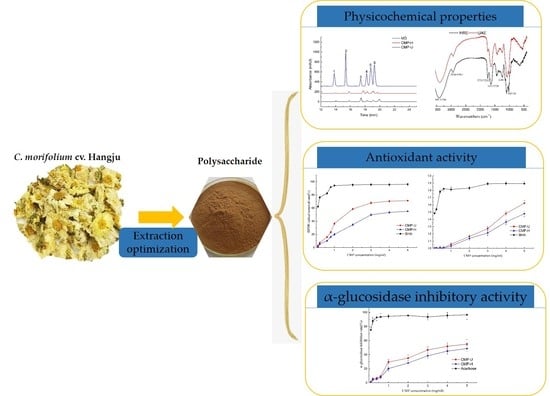Extraction Optimization and Evaluation of the Antioxidant and α-Glucosidase Inhibitory Activity of Polysaccharides from Chrysanthemum morifolium cv. Hangju
Abstract
1. Introduction
2. Materials and Methods
2.1. Plant Material and Chemicals
2.2. Extraction of Polysaccharides from C. morifolium
2.2.1. Single Factor Analysis
2.2.2. RSM Optimization
2.2.3. Heat Reflux Extraction
2.3. Determination of Chemical Composition and Molecular Weights
2.4. Determination of Monosaccharide Composition
2.5. Fourier Transform Infrared Spectrum Analysis
2.6. Antioxidant Activities of C. morifolium Polysaccharides
2.6.1. DPPH Free Radical Scavenging Activity
2.6.2. Hydroxyl Radical Scavenging Activity
2.6.3. Ferrous Chelating Activity
2.6.4. Reducing Power
2.7. Alpha-Glucosidase Inhibition Assay
2.8. Statistical Analysis
3. Results and Discussion
3.1. Single Factor Assessment
3.1.1. Effect of the Ratio of Liquid-to-Solid on the Yield of CMP
3.1.2. Effect of Ultrasonic Power on the Yield of CMP
3.1.3. Effect of Extraction Time on the Yield of CMP
3.2. Extraction and Optimization of CMP by RSM
3.2.1. Model Fitting
3.2.2. Response Surface Analysis and Verification of the Model
3.3. Physicochemical Properties of CMPs
3.4. Molecular Weight Distribution of CMPs
3.5. FT-IR Analysis
3.6. Antioxidant Activity Assay of CMPs by Different Extraction Methods
3.6.1. Scavenging Activity of DPPH Radicals
3.6.2. Scavenging of Hydroxyl Radicals
3.6.3. Ferrous Chelating Activity
3.6.4. Total Reducing Power
3.7. Alpha-Glucosidase Inhibitory Activities
3.8. Relationship between Physicochemical Properties of CMPs and Their Antioxidant Activity or α-Glucosidase Inhibition Activities
4. Conclusions
Author Contributions
Funding
Conflicts of Interest
Abbreviations
References
- Pisoschi, A.M.; Pop, A. The role of antioxidants in the chemistry of oxidative stress. Eur. J. Med. Chem. 2015, 97, 55–74. [Google Scholar] [CrossRef] [PubMed]
- Li, S.; Tan, H.; Wang, N.; Zhang, Z.; Lao, L.; Wong, C.; Feng, Y. The role of oxidative stress and antioxidants in liver diseases. Int. J. Mol. Sci. 2015, 16, 26087–26124. [Google Scholar] [CrossRef] [PubMed]
- Oroian, M.; Escriche, I. Antioxidants: Characterization, natural sources, extraction and analysis. Food Res. Int. 2015, 74, 10–36. [Google Scholar] [CrossRef]
- Embuscado, M.E. Spices and herbs: Natural sources of antioxidants - a mini review. J. Funct. Foods 2015, 18, 811–819. [Google Scholar] [CrossRef]
- Xu, D.; Li, Y.; Meng, X.; Zhou, T.; Zhou, Y.; Zheng, J.; Zhang, J.; Li, H. Natural antioxidants in foods and medicinal plants: Extraction, assessment and resources. Int. J. Mol. Sci. 2017, 18, 96. [Google Scholar] [CrossRef]
- Zhang, N.; He, Z.; He, S.; Jing, P. Insights into the importance of dietary chrysanthemum flower (Chrysanthemum morifolium cv. Hangju)-wolfberry (Lycium barbarum fruit) combination in antioxidant and anti-inflammatory properties. Food Res. Int. 2019, 116, 810–818. [Google Scholar] [CrossRef]
- Wang, Y.; Xu, Z.; Wen, X.; Li, M.; Pang, S.; Huang, Y.; Ni, Y. The formation and bioactivities of green substances in Chrysanthemum morifolium tea. Food Chem. 2019, 286, 268–274. [Google Scholar] [CrossRef]
- Gong, J.; Chu, B.; Gong, L.; Fang, Z.; Zhang, X.; Qiu, S.; Wang, J.; Xiang, Y.; Xiao, G.; Yuan, H.; et al. Comparison of phenolic compounds and the antioxidant activities of fifteen Chrysanthemum morifolium Ramat cv. ‘Hangbaiju’ in China. Antioxidants 2019, 8, 325. [Google Scholar] [CrossRef]
- Liu, Y.; Mou, X.; Zhou, D.; Zhou, D.; Shou, C. Extraction of flavonoids from Chrysanthemum morifolium and antitumor activity in vitro. Exp. Ther. Med. 2018, 15, 1203–1210. [Google Scholar] [CrossRef]
- Yang, P.; Yang, Y.; Feng, Z.; Jiang, J.; Zhang, P. Six new compounds from the flowers of Chrysanthemum morifolium and their biological activities. Bioorg. Chem. 2019, 82, 139–144. [Google Scholar] [CrossRef] [PubMed]
- Tao, J.; Duan, J.; Jiang, S.; Feng, N.; Qiu, W.; Ling, Y. Polysaccharides from Chrysanthemum morifolium Ramat ameliorate colitis rats by modulating the intestinal microbiota community. Oncotarget 2017, 8, 80790–80803. [Google Scholar] [CrossRef] [PubMed]
- Tao, J.; Duan, J.; Zhang, W.; Jiang, S.; Guo, J.; Wei, D. Polysaccharides from Chrysanthemum morifolium ramat ameliorate colitis rats via regulation of the metabolic profiling and NF-κ B/TLR4 and IL-6/JAK2/STAT3 signaling pathways. Front. Pharmacol. 2018, 9, 1–14. [Google Scholar] [CrossRef] [PubMed]
- Zheng, C.; Dong, Q.; Chen, H.; Cong, Q.; Ding, K. Structural characterization of a polysaccharide from Chrysanthemum morifolium flowers and its antioxidant activity. Carbohydr. Polym. 2015, 130, 113–121. [Google Scholar] [CrossRef] [PubMed]
- Zheng, C.; Dong, Q.; Du, Z.; Wang, P.; Ding, K. Structural elucidation of a polysaccharide from Chrysanthemum morifolium flowers with anti-angiogenic activity. Int. J. Biol. Macromol. 2015, 79, 674–680. [Google Scholar] [CrossRef]
- Luyen, B.T.T.; Tai, B.H.; Thao, N.P.; Cha, J.Y.; Lee, H.Y.; Lee, Y.M.; Kim, Y.H. Anti-inflammatory components of Chrysanthemum indicum flowers. Bioorg. Med. Chem. Lett. 2015, 25, 266–269. [Google Scholar] [CrossRef]
- Zhang, Z.; Kong, F.; Ni, H.; Mo, Z.; Wan, J.; Hua, D.; Yan, C. Structural characterization, α-glucosidase inhibitory and DPPH scavenging activities of polysaccharides from guava. Carbohydr. Polym. 2016, 144, 106–114. [Google Scholar] [CrossRef]
- Chen, G.; Fang, C.; Chen, X.; Wang, Z.; Liu, M.; Kan, J. High-pressure ultrasonic-assisted extraction of polysaccharides from Mentha haplocalyx: Structure, functional and biological activities. Ind. Crop. Prod. 2019, 130, 273–284. [Google Scholar] [CrossRef]
- Thambiraj, S.R.; Phillips, M.; Koyyalamudi, S.R.; Reddy, N. Yellow lupin (Lupinus luteus L.) polysaccharides: Antioxidant, immunomodulatory and prebiotic activities and their structural characterization. Food Chem. 2018, 267, 319–328. [Google Scholar] [CrossRef]
- Chen, C.; You, L.; Abbasi, A.M.; Fu, X.; Liu, R.H. Optimization for ultrasound extraction of polysaccharides from mulberry fruits with antioxidant and hyperglycemic activity in vitro. Carbohydr. Polym. 2015, 130, 122–132. [Google Scholar] [CrossRef]
- Yang, R.; Zhao, C.; Chen, X.; Chan, S.; Wu, J. Chemical properties and bioactivities of Goji (Lycium barbarum) polysaccharides extracted by different methods. J. Funct. Foods 2015, 17, 903–909. [Google Scholar] [CrossRef]
- Hou, M.; Hu, W.; Wang, A.; Xiu, Z.; Shi, Y.; Hao, K.; Sun, X.; Cao, D.; Lu, R.; Sun, J. Ultrasound-assisted extraction of total flavonoids from Pteris cretica L.: Process optimization, HPLC Analysis, and evaluation of antioxidant activity. Antioxidants 2019, 8, 425. [Google Scholar] [CrossRef] [PubMed]
- Xu, X.; Meng, J.; Mao, Q.; Shang, A.; Li, B.; Zhao, C.; Tang, G.; Cao, S.; Wei, X.; Gan, R.; et al. Effects of tannase and ultrasound treatment on the bioactive compounds and antioxidant activity of green tea extract. Antioxidants 2019, 8, 362. [Google Scholar] [CrossRef]
- Yang, Q.; Gan, R.; Ge, Y.; Zhang, D.; Corke, A.H. Ultrasonic treatment increases extraction rate of common bean (Phaseolus vulgaris L.) antioxidants. Antioxidants 2019, 8, 83. [Google Scholar] [CrossRef]
- Guo, H.; Yuan, Q.; Fu, Y.; Liu, W.; Su, Y.; Liu, H.; Wu, C.; Zhao, L.; Zhang, Q.; Lin, D.; et al. Extraction optimization and effects of extraction methods on the chemical structures and antioxidant activities of polysaccharides from snow chrysanthemum (Coreopsis tinctoria). Polymers 2019, 11, 215. [Google Scholar] [CrossRef] [PubMed]
- Ying, Z.; Han, X.; Li, J. Ultrasound-assisted extraction of polysaccharides from mulberry leaves. Food Chem. 2011, 127, 1273–1279. [Google Scholar] [CrossRef] [PubMed]
- Shen, S.; Cheng, H.; Li, X.; Li, T.; Yuan, M.; Zhou, Y.; Ding, C. Effects of extraction methods on antioxidant activities of polysaccharides from camellia seed cake. Eur. Food Res. Technol. 2014, 238, 1015–1021. [Google Scholar] [CrossRef]
- Bradford, M.M. A rapid and sensitive method for the quantitation of microgram quantities of protein utilizing the principle of protein-dye binding. Anal. Biochem. 1976, 72, 248–254. [Google Scholar] [CrossRef]
- Bitter, T. A modified uronic acid carbazole reaction. Anal. Biochem. 1962, 4, 330–334. [Google Scholar] [CrossRef]
- Wu, X.; Jiang, W.; Lu, J.; Yu, Y.; Wu, B. Analysis of the monosaccharide composition of water-soluble polysaccharides from Sargassum fusiforme by high performance liquid chromatography/electrospray ionisation mass spectrometry. Food Chem. 2014, 145, 976–983. [Google Scholar] [CrossRef]
- Jing, S.; Chai, W.; Guo, G.; Zhang, X.; Dai, J.; Yan, L. Comparison of antioxidant and antiproliferative activity between Kunlun Chrysanthemum flowers polysaccharides (KCCP) and fraction PII separated by column chromatography. J. Chromatogr. B 2016, 1019, 169–177. [Google Scholar] [CrossRef]
- Wang, Y.; Shao, S.; Xu, P.; Chen, H.; Lin-Shiau, S.; Deng, Y.; Lin, J. Fermentation process enhanced production and bioactivities of oolong tea polysaccharides. Food Res. Int. 2012, 46, 158–166. [Google Scholar] [CrossRef]
- Zheng, Y.; Li, Y.; Wang, W.D. Optimization of ultrasonic-assisted extraction and in vitro antioxidant activities of polysaccharides from Trametes orientalis. Carbohydr. Polym. 2014, 111, 315–323. [Google Scholar] [CrossRef] [PubMed]
- Maran, J.P.; Manikandan, S.; Thirugnanasambandham, K.; Vigna Nivetha, C.; Dinesh, R. Box–Behnken design based statistical modeling for ultrasound-assisted extraction of corn silk polysaccharide. Carbohydr. Polym. 2013, 92, 604–611. [Google Scholar] [CrossRef] [PubMed]
- Zhou, C.; Yu, X.; Zhang, Y.; He, R.; Ma, H. Ultrasonic degradation, purification and analysis of structure and antioxidant activity of polysaccharide from Porphyra yezoensis Udea. Carbohydr. Polym. 2012, 87, 2046–2051. [Google Scholar] [CrossRef]
- Chen, H.; Zhang, M.; Xie, B. Quantification of uronic acids in tea polysaccharide conjugates and their antioxidant properties. J. Agric. Food Chem. 2004, 52, 3333–3336. [Google Scholar] [CrossRef]
- He, P.; Zhang, A.; Zhang, F.; Linhardt, R.J.; Sun, P. Structure and bioactivity of a polysaccharide containing uronic acid from Polyporus umbellatus sclerotia. Carbohydr. Polym. 2016, 152, 222–230. [Google Scholar] [CrossRef]
- Chen, R.; Tan, L.; Jin, C.; Lu, J.; Tian, L.; Chang, Q.; Wang, K. Extraction, isolation, characterization and antioxidant activity of polysaccharides from Astragalus membranaceus. Ind. Crop. Prod. 2015, 77, 434–443. [Google Scholar] [CrossRef]
- Wang, N.; Zhang, Y.; Wang, X.; Huang, X.; Fei, Y.; Yu, Y.; Shou, D. Antioxidant property of water-soluble polysaccharides from Poria cocos Wolf using different extraction methods. Int. J. Biol. Macromol. 2016, 83, 103–110. [Google Scholar] [CrossRef]
- Yan, Y.; Li, X.; Wan, M.; Chen, J.; Li, S.; Cao, M.; Zhang, D. Effect of extraction methods on property and bioactivity of water-soluble polysaccharides from Amomum villosum. Carbohydr. Polym. 2015, 117, 632–635. [Google Scholar] [CrossRef]
- Kpodo, F.M.; Agbenorhevi, J.K.; Bingham, R.J.; Oduro, I.N.; Morris, G.A.; Kontogiorgos, V. Pectin isolation and characterization from six okra genotypes. Food Hydrocoll. 2017, 72, 323–330. [Google Scholar] [CrossRef]
- Sharma, O.P.; Bhat, T.K. DPPH antioxidant assay revisited. Food Chem. 2009, 113, 1202–1205. [Google Scholar] [CrossRef]
- Xu, R.; Shang, N.; Li, P. In vitro and in vivo antioxidant activity of exopolysaccharide fractions from Bifidobacterium animalis RH. Anaerobe 2011, 17, 226–231. [Google Scholar] [CrossRef] [PubMed]
- Fan, J.; Wu, Z.; Zhao, T.; Sun, Y.; Ye, H.; Xu, R.; Zeng, X. Characterization, antioxidant and hepatoprotective activities of polysaccharides from Ilex latifolia Thunb. Carbohydr. Polym. 2014, 101, 990–997. [Google Scholar] [CrossRef] [PubMed]
- Thambiraj, S.R.; Phillips, M.; Koyyalamudi, S.R.; Reddy, N. Antioxidant activities and characterisation of polysaccharides isolated from the seeds of Lupinus angustifolius. Ind. Crop. Prod. 2015, 74, 950–956. [Google Scholar] [CrossRef]
- Xu, Y.; Cai, F.; Yu, Z.; Zhang, L.; Li, X.; Yang, Y.; Liu, G. Optimisation of pressurised water extraction of polysaccharides from blackcurrant and its antioxidant activity. Food Chem. 2016, 194, 650–658. [Google Scholar] [CrossRef]
- Kao, T.; Chen, B. Functional components in soybean cake and their effects on antioxidant activity. J. Agric. Food Chem. 2006, 54, 7544–7555. [Google Scholar] [CrossRef]
- Song, H.; Zhang, Q.; Zhang, Z.; Wang, J. In vitro antioxidant activity of polysaccharides extracted from Bryopsis plumosa. Carbohydr. Polym. 2010, 80, 1057–1061. [Google Scholar] [CrossRef]
- Jing, L.; Zong, S.; Li, J.; Surhio, M.M.; Ye, M. Purification, structural features and inhibition activity on α-glucosidase of a novel polysaccharide from Lachnum YM406. Process. Biochem. 2016, 51, 1706–1713. [Google Scholar] [CrossRef]
- Chen, H.; Wang, Z.; Qu, Z.; Fu, L.; Dong, P.; Zhang, X. Physicochemical characterization and antioxidant activity of a polysaccharide isolated from oolong tea. Eur. Food Res. Technol. 2009, 229, 629–635. [Google Scholar] [CrossRef]
- Zhang, H.; Zhao, H.; Yao, L.; Yang, X.; Shen, S.; Wang, J.; Wang, Z.; Regenstein, J.M.; Geng, L. Isolation, physicochemical properties, and in vitro antioxidant activity of polysaccharides extracted from different parts of Pinus koraiensis. J. Wood Chem. Technol. 2017, 37, 225–240. [Google Scholar] [CrossRef]
- Dong, H.; Lin, S.; Zhang, Q.; Chen, H.; Lan, W.; Li, H.; He, J.; Qin, W. Effect of extraction methods on the properties and antioxidant activities of Chuanminshen violaceum polysaccharides. Int. J. Biol. Macromol. 2016, 93, 179–185. [Google Scholar] [CrossRef] [PubMed]
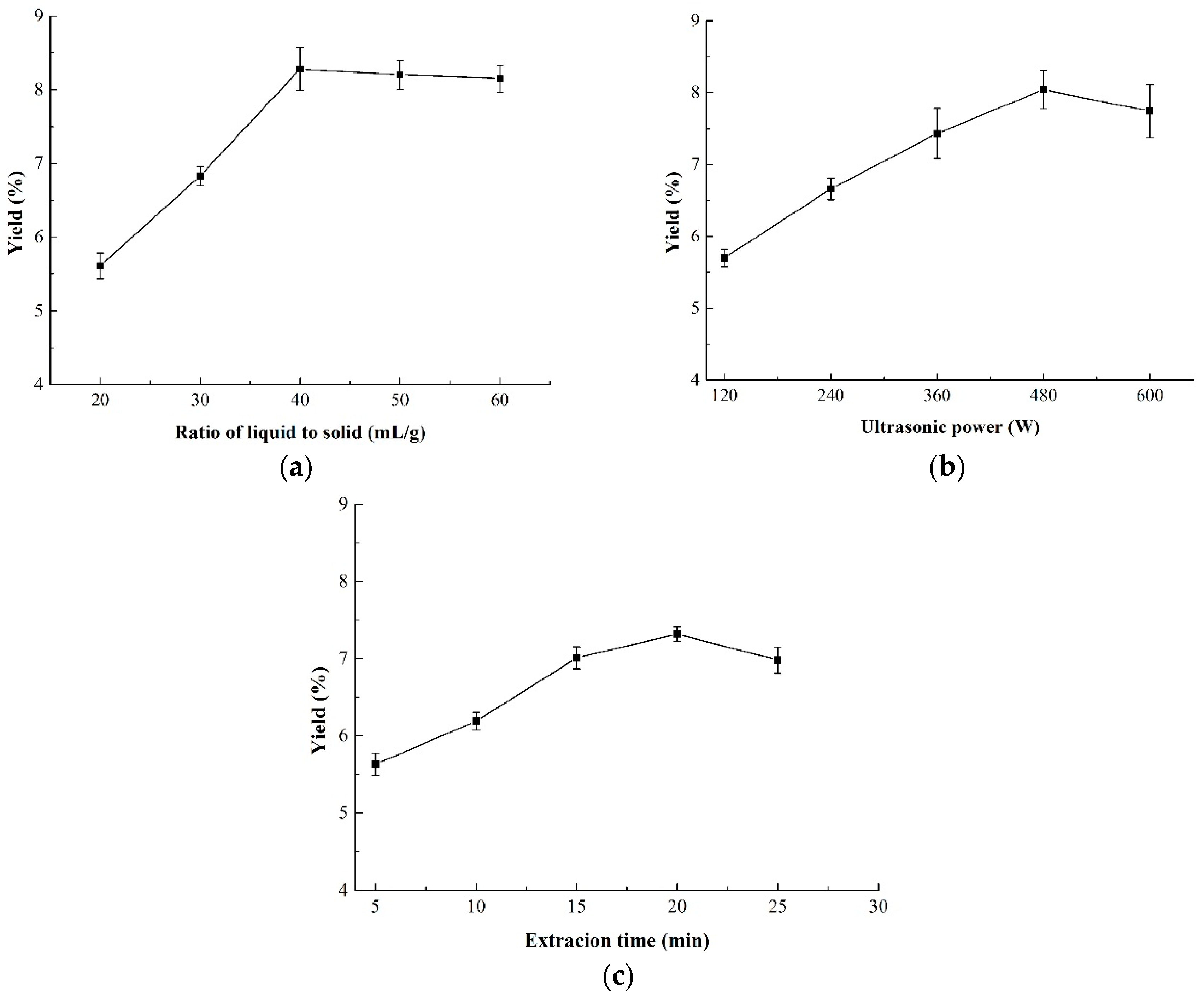
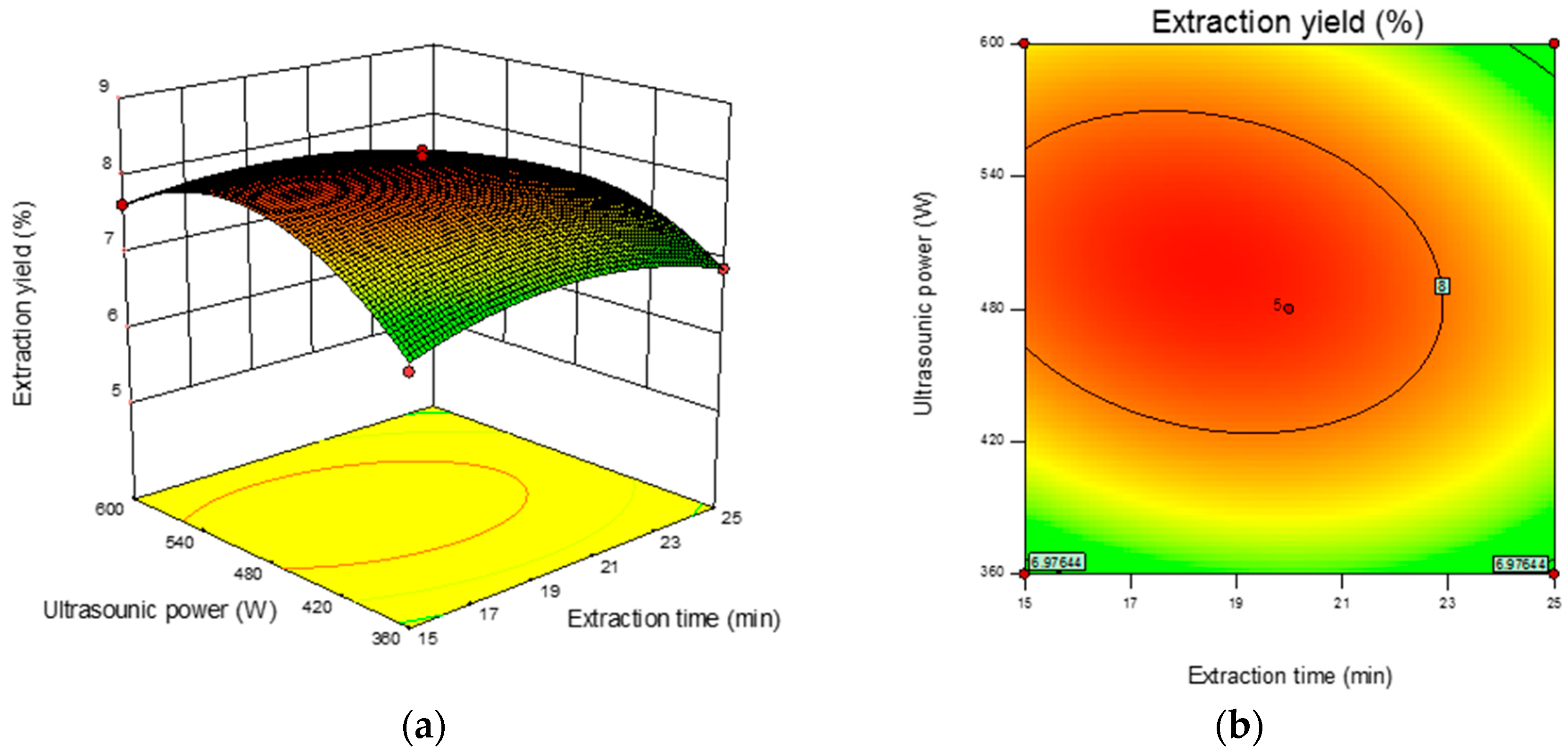
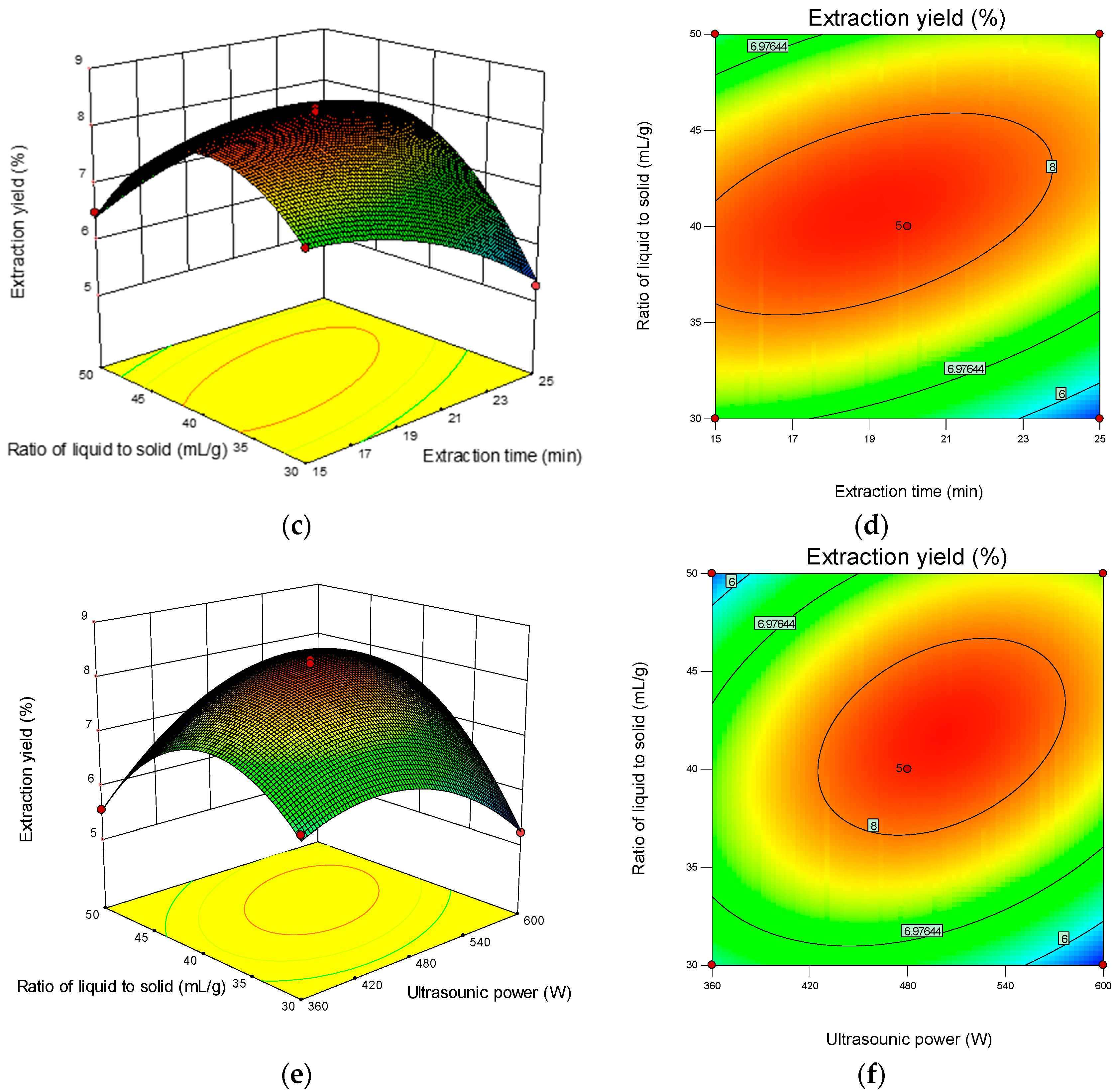
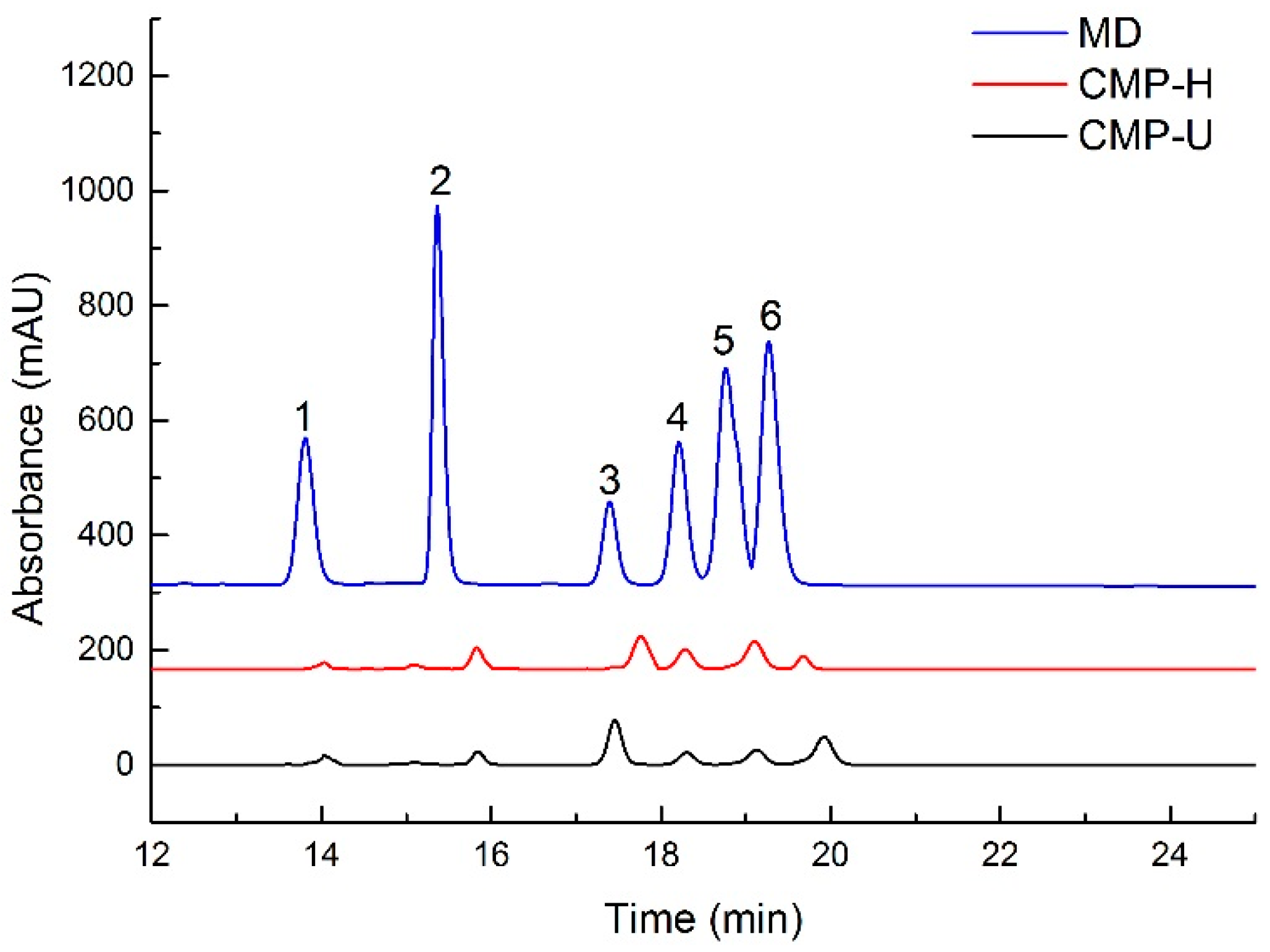
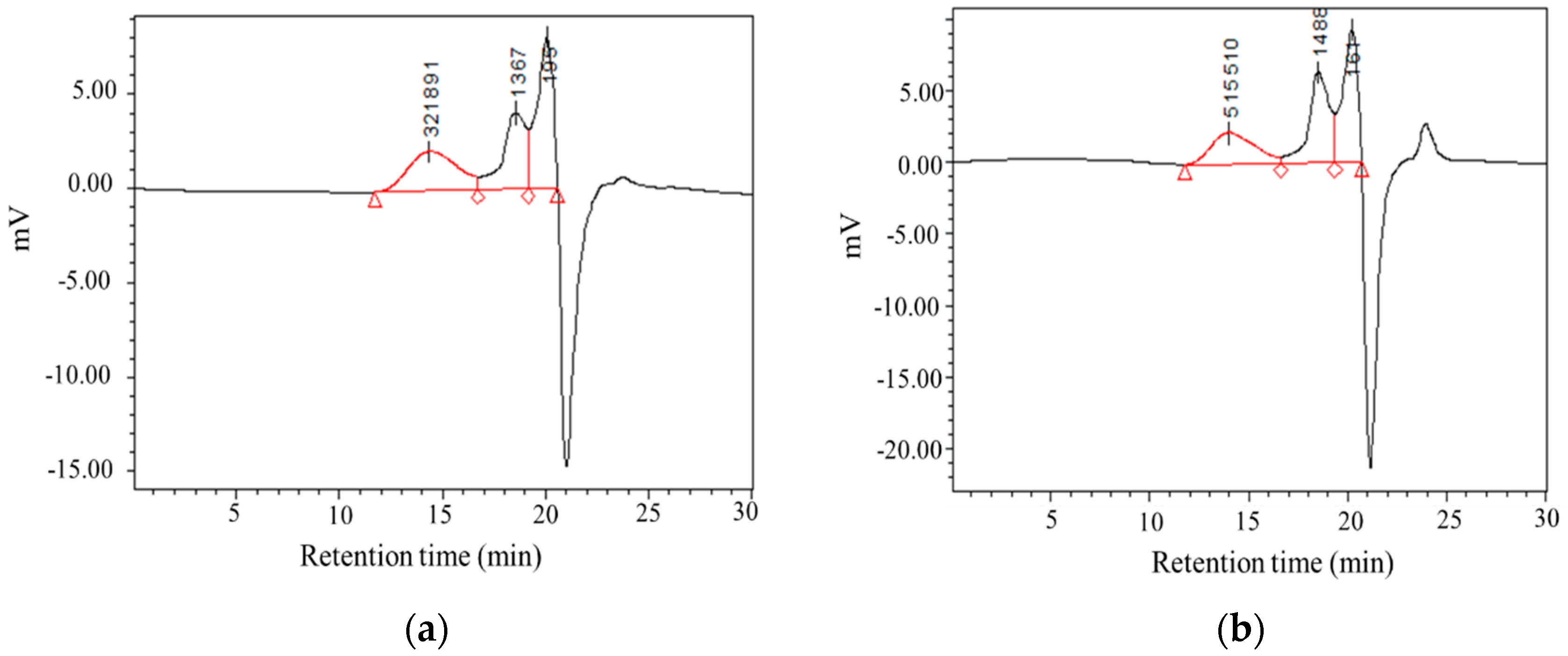
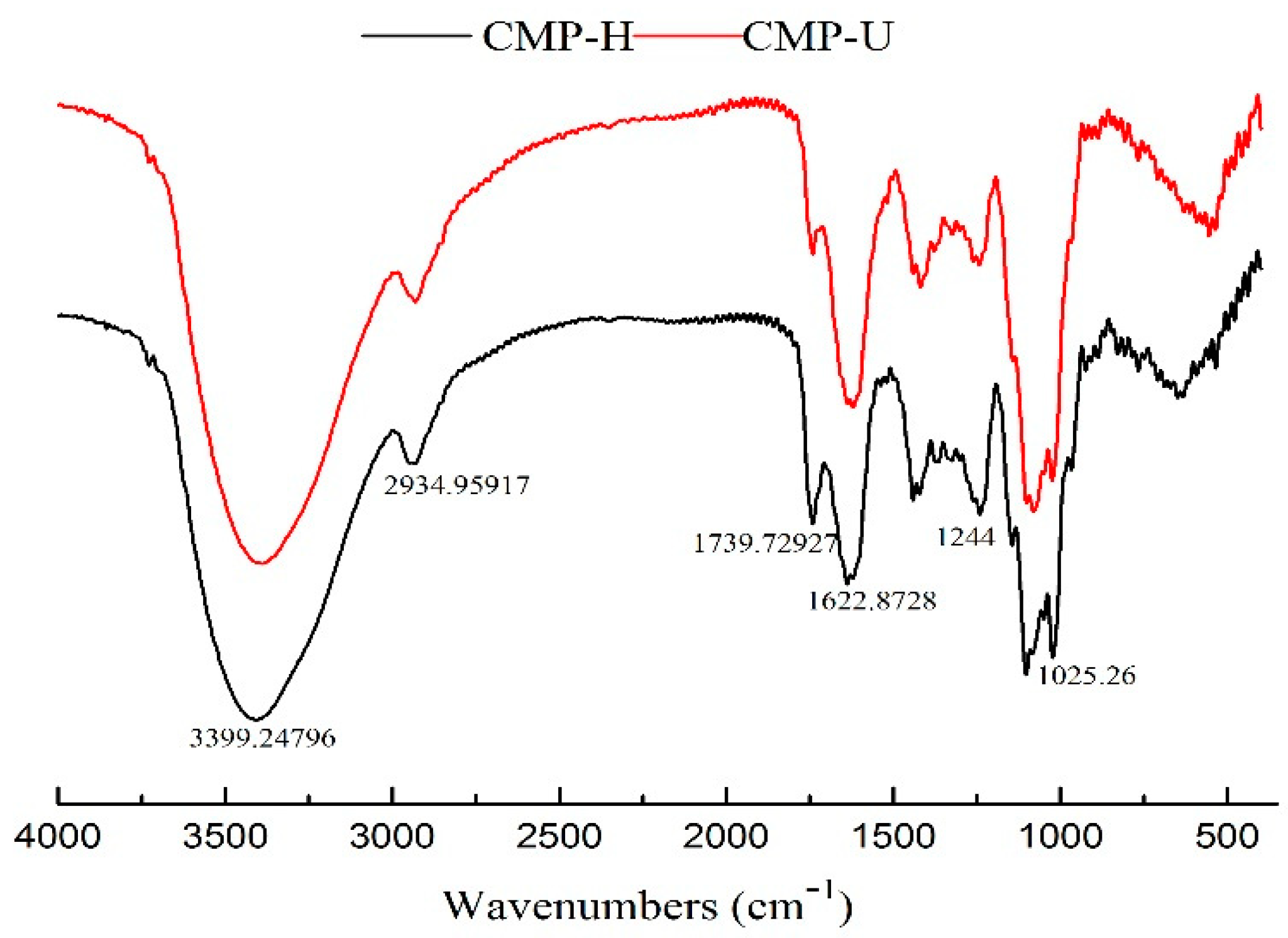
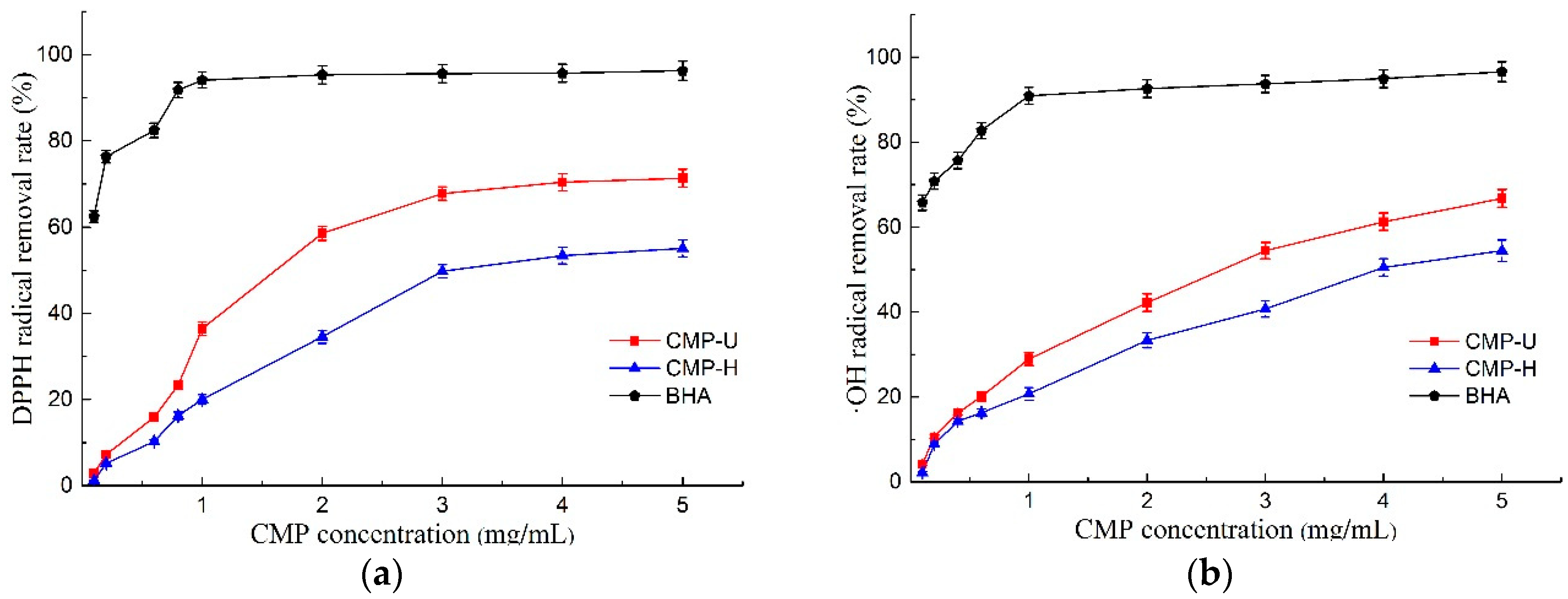
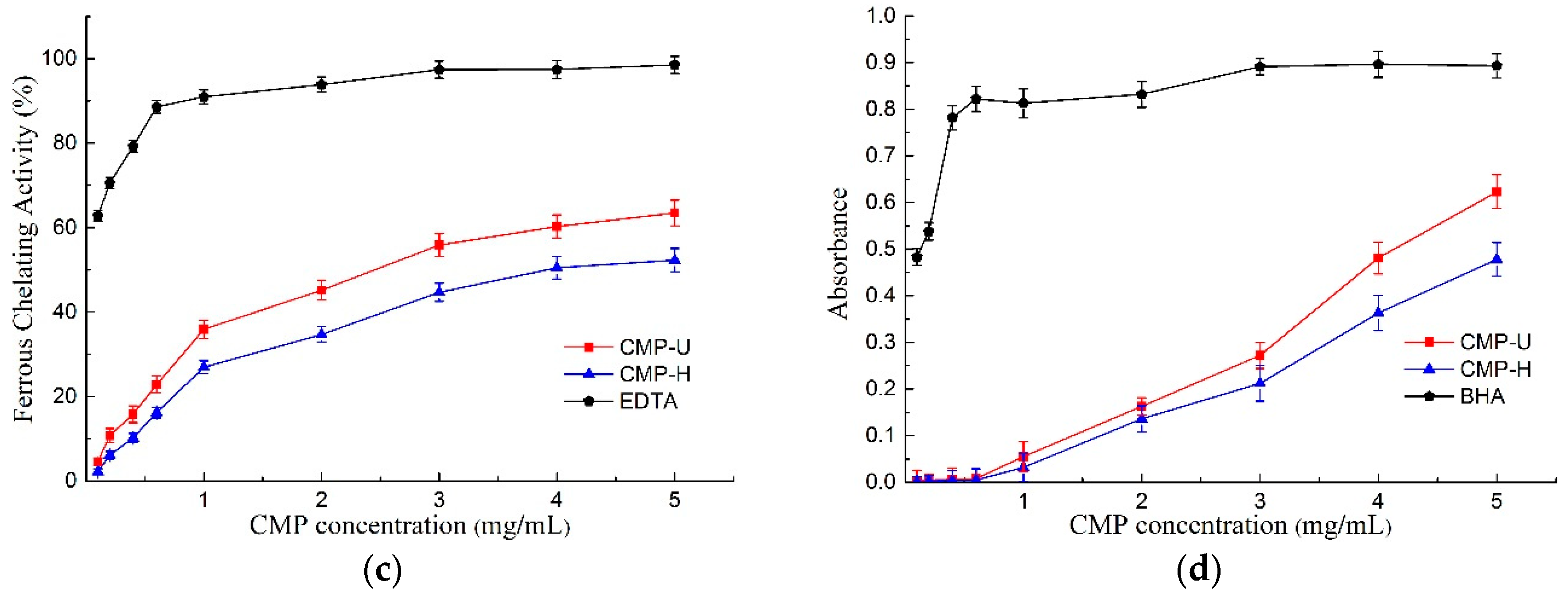
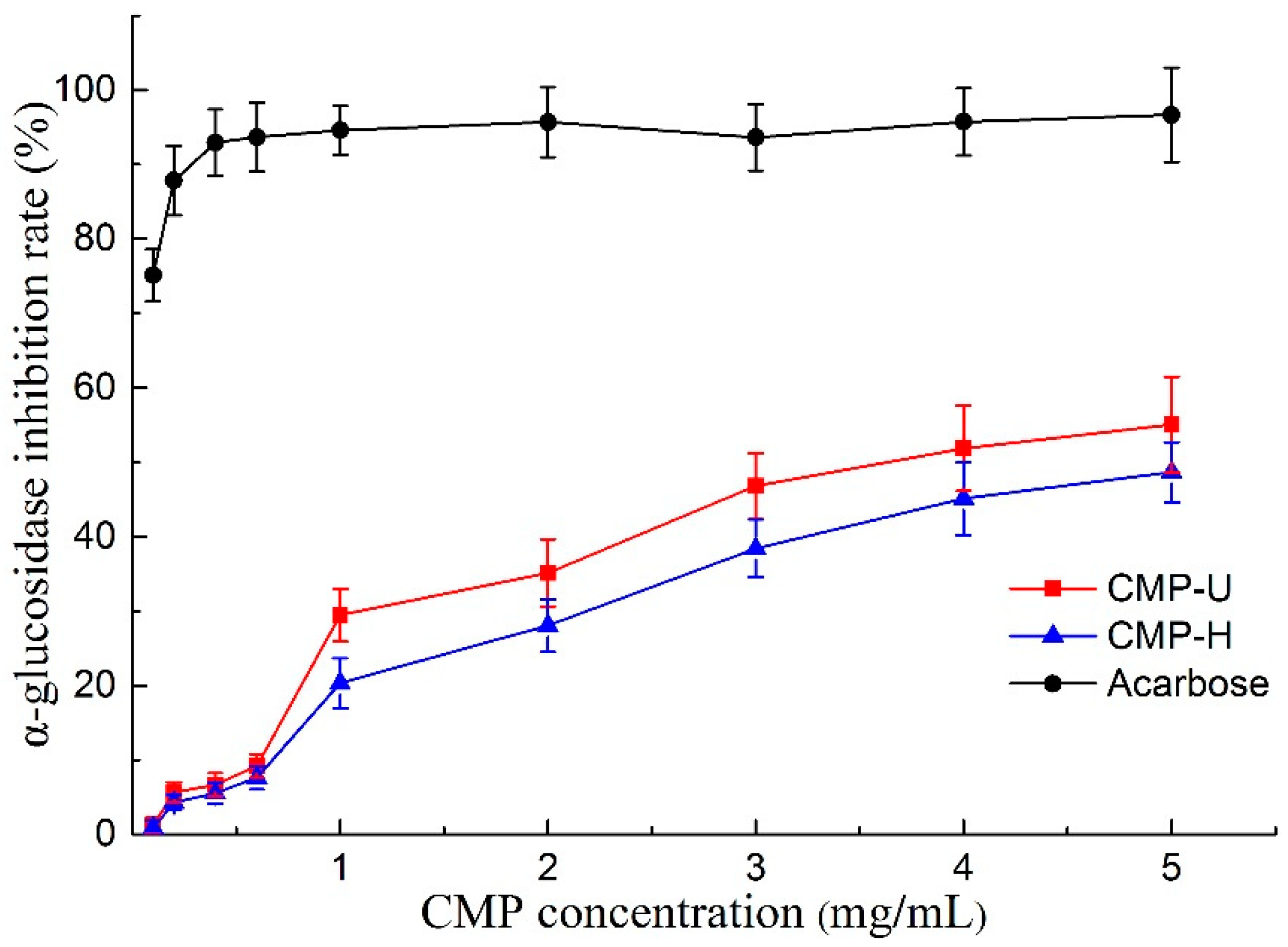
| Run | Levels on Independent Factors | Extraction Yield (%) | ||
|---|---|---|---|---|
| X1 (min) | X2 (W) | X3 (mL/g) | ||
| 1 | 20 (0) | 480 (0) | 40 (0) | 8.29 |
| 2 | 25 (1) | 480 (0) | 30 (−1) | 5.28 |
| 3 | 20 (0) | 480 (0) | 40 (0) | 8.36 |
| 4 | 25 (1) | 360 (−1) | 40 (0) | 6.88 |
| 5 | 20 (0) | 600 (1) | 30 (−1) | 5.23 |
| 6 | 20 (0) | 360 (−1) | 30 (−1) | 6.46 |
| 7 | 20 (0) | 480 (0) | 40 (0) | 8.20 |
| 8 | 15 (−1) | 480 (0) | 50 (1) | 6.50 |
| 9 | 20 (0) | 360 (−1) | 50 (1) | 5.56 |
| 10 | 20 (0) | 600 (1) | 50 (1) | 7.22 |
| 11 | 25 (1) | 480 (0) | 50 (1) | 7.31 |
| 12 | 15 (−1) | 600 (1) | 40 (0) | 7.63 |
| 13 | 15 (−1) | 360 (−1) | 40 (0) | 6.75 |
| 14 | 20 (0) | 480 (0) | 40 (0) | 8.29 |
| 15 | 25 (1) | 600 (1) | 40 (0) | 6.89 |
| 16 | 20 (0) | 480 (0) | 40 (0) | 8.11 |
| 17 | 15 (−1) | 480 (0) | 30 (−1) | 7.13 |
| Source | Sum of Squares | Df | Mean Square | F-Value | p-Value |
|---|---|---|---|---|---|
| Model | 17.03 | 9 | 1.89 | 133.87 | <0.0001 |
| X1 | 0.34 | 1 | 0.34 | 24.07 | 0.0017 |
| X2 | 0.22 | 1 | 0.22 | 15.40 | 0.0057 |
| X3 | 0.78 | 1 | 0.78 | 54.81 | 0.0001 |
| X1X2 | 0.19 | 1 | 0.19 | 13.38 | 0.0081 |
| X1X3 | 1.77 | 1 | 1.77 | 125.11 | <0.0001 |
| X2X3 | 2.09 | 1 | 2.09 | 147.68 | <0.0001 |
| X12 | 0.63 | 1 | 0.63 | 44.71 | 0.0003 |
| X22 | 2.87 | 1 | 2.87 | 202.68 | <0.0001 |
| X32 | 7.20 | 1 | 7.20 | 509.09 | <0.0001 |
| Residual | 0.099 | 7 | 0.014 | ||
| Lack of fit | 0.062 | 3 | 0.021 | 2.20 | 0.2312 |
| Pure error | 0.037 | 4 | 9.350 × 10−3 | ||
| Cor total | 17.31 | 16 | |||
| R2 | 0.9942 | ||||
| Adjusted R2 | 0.9868 | ||||
| CV % | 1.68 |
| Items | CMP-U | CMP-H |
|---|---|---|
| Yield (%) | 8.29 ± 0.18 a | 7.25 ± 0.10 b |
| Protein content (%) | 2.56 ± 0.08 b | 3.36 ± 0.09 a |
| Uronic acid (%) | 7.08 ± 0.25 a | 1.61 ± 0.10 b |
| Constituent monosaccharides and molar ratios | ||
| Glucose | 1 | 1 |
| Fructose | 0.011 | 0.007 |
| Rhamnose | 0.040 | 0.052 |
| Galactose | 0.065 | 0.095 |
| Xylose | 0.113 | 0.214 |
| Arabinose | 0.184 | 0.045 |
| Molecular Weight Distribution | ||||
|---|---|---|---|---|
| Polysaccharides | Retention Time (min) | Mw (Da) | Mn (Da) | Area % |
| CMP-U | 13.987 | 669,143 | 153,373 | 26.27 |
| 18.492 | 2115 | 1231 | 36.21 | |
| 20.205 | 214 | 179 | 37.51 | |
| CMP-H | 14.350 | 521,905 | 108,418 | 37.44 |
| 18.557 | 2628 | 1464 | 28.74 | |
| 20.058 | 321 | 225 | 33.82 | |
© 2020 by the authors. Licensee MDPI, Basel, Switzerland. This article is an open access article distributed under the terms and conditions of the Creative Commons Attribution (CC BY) license (http://creativecommons.org/licenses/by/4.0/).
Share and Cite
Hou, X.; Huang, X.; Li, J.; Jiang, G.; Shen, G.; Li, S.; Luo, Q.; Wu, H.; Li, M.; Liu, X.; et al. Extraction Optimization and Evaluation of the Antioxidant and α-Glucosidase Inhibitory Activity of Polysaccharides from Chrysanthemum morifolium cv. Hangju. Antioxidants 2020, 9, 59. https://doi.org/10.3390/antiox9010059
Hou X, Huang X, Li J, Jiang G, Shen G, Li S, Luo Q, Wu H, Li M, Liu X, et al. Extraction Optimization and Evaluation of the Antioxidant and α-Glucosidase Inhibitory Activity of Polysaccharides from Chrysanthemum morifolium cv. Hangju. Antioxidants. 2020; 9(1):59. https://doi.org/10.3390/antiox9010059
Chicago/Turabian StyleHou, Xiaoyan, Xia Huang, Jianlong Li, Guangyang Jiang, Guanghui Shen, Shanshan Li, Qingying Luo, Hejun Wu, Meiliang Li, Xingyan Liu, and et al. 2020. "Extraction Optimization and Evaluation of the Antioxidant and α-Glucosidase Inhibitory Activity of Polysaccharides from Chrysanthemum morifolium cv. Hangju" Antioxidants 9, no. 1: 59. https://doi.org/10.3390/antiox9010059
APA StyleHou, X., Huang, X., Li, J., Jiang, G., Shen, G., Li, S., Luo, Q., Wu, H., Li, M., Liu, X., Chen, A., Ye, M., & Zhang, Z. (2020). Extraction Optimization and Evaluation of the Antioxidant and α-Glucosidase Inhibitory Activity of Polysaccharides from Chrysanthemum morifolium cv. Hangju. Antioxidants, 9(1), 59. https://doi.org/10.3390/antiox9010059




